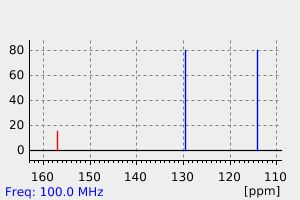噁唑-2-酮 | 27584-70-9
中文名称
噁唑-2-酮
中文别名
——
英文名称
4-oxazolin-2-one
英文别名
oxazolone;2-oxazolone;oxazol-2(3H)-one;3H-oxazol-2-one;3H-1,3-oxazol-2-one
CAS
27584-70-9
化学式
C3H3NO2
mdl
MFCD00075369
分子量
85.0623
InChiKey
XYVMOLOUBJBNBF-UHFFFAOYSA-N
BEILSTEIN
——
EINECS
——
-
物化性质
-
计算性质
-
ADMET
-
安全信息
-
SDS
-
制备方法与用途
-
上下游信息
-
文献信息
-
表征谱图
-
同类化合物
-
相关功能分类
-
相关结构分类
物化性质
-
熔点:111-113 °C
-
密度:1.296±0.06 g/cm3(Predicted)
计算性质
-
辛醇/水分配系数(LogP):-0.3
-
重原子数:6
-
可旋转键数:0
-
环数:1.0
-
sp3杂化的碳原子比例:0.0
-
拓扑面积:38.3
-
氢给体数:1
-
氢受体数:2
安全信息
-
海关编码:2934999090
-
危险性防范说明:P261,P305+P351+P338
-
危险性描述:H302,H315,H319,H335
-
储存条件:存储条件:2-8℃,请保持干燥并密封保存。
SDS
上下游信息
-
上游原料
中文名称 英文名称 CAS号 化学式 分子量 恶唑 oxazol 288-42-6 C3H3NO 69.0629
反应信息
-
作为反应物:参考文献:名称:Otsubo, Teruyuki; Matsukawa, Chiyoko; Ishizuka, Tadao, Heterocycles, 1992, vol. 33, # 1, p. 131 - 134摘要:DOI:
-
作为产物:描述:参考文献:名称:Tavernier, Dirk; Damme, Sabine van; Ricquier, Patrick, Bulletin des Societes Chimiques Belges, 1988, vol. 97, # 11, p. 859 - 866摘要:DOI:
-
作为试剂:描述:(1S,2R)-3-(2-bromoethyl)cyclohex-5-ene-1,2-diol 在 sodium hydroxide 、 三丁基膦 、 sodium hydride 、 N,N-二异丙基乙胺 、 噁唑-2-酮 、 偶氮二甲酸二乙酯 作用下, 以 四氢呋喃 、 甲醇 、 二氯甲烷 、 二甲基亚砜 为溶剂, 反应 71.33h, 生成 3-{2-[(5S,6R)-6-(2-Bromo-6-methoxy-phenoxy)-5-(tert-butyl-dimethyl-silanyloxy)-cyclohex-1-enyl]-ethyl}-3H-oxazol-2-one参考文献:名称:Toward a Practical Synthesis of Morphine. The First Several Generations of a Radical Cyclization Approach摘要:DOI:10.1055/s-1998-5931
文献信息
-
Activation of carboxyl groups by diphenyl 2-oxo-3-oxazolinylphosphonate作者:Takehisa Kunieda、Tsunehiko Higuchi、Yoshihiro Abe、Masaaki HirobeDOI:10.1016/s0040-4020(01)91572-8日期:1983.1sphonate [DPPOx] has been newly introduced as a carboxyl-activating reagent which permits a facile direct preparation of 3-acyl-2-oxazolones and amides including peptides from a wide variety of carboxylic acids The 3-acyl-2-oxazolides also serve as versatile reactive agents for highly chemoselective acyl-transfer to the nucleophilic species such as amines, alcohols and thiols, providing convenient
-
Compounds which mimic the chemical and biological properties of discodermolide
-
2-Dienylphenacyloxazolones and an intramolecular Diels–Alder approach to the A–B–C ring system of phenanthridone alkaloids作者:Faith Corbo Gaenzler、Chen (Lisa) Guo、Yun-Wei Zhang、Mohammad E. Azab、Mounir A.I. Salem、Dong Ping Fan、Michael B. SmithDOI:10.1016/j.tet.2009.08.066日期:2009.10A general route to the A–B–C ring system of phenanthridone alkaloids is available by acylation of 2-oxa-zolone with a 2-butadienylbenzoic acid derivative, followed by an intramolecular Diels–Alder reaction and hydrolysis.
-
[EN] ASGPR-BINDING COMPOUNDS FOR THE DEGRADATION OF EXTRACELLULAR PROTEINS<br/>[FR] COMPOSÉS SE LIANT À L'ASGPR POUR LA DÉGRADATION DE PROTÉINES EXTRACELLULAIRES申请人:AVILAR THERAPEUTICS INC公开号:WO2021155317A1公开(公告)日:2021-08-05Compounds and compositions that have an asialoglycoprotein receptor (ASGPR) binding ligand bound to an extracellular protein binding ligand for the selective degradation of the target extracellular protein in vivo to treat disorders mediated by the extracellular protein are described.
-
Chemoenzymatic synthesis of the morphine skeleton via radical cyclization and a C10C11 closure作者:Gabor Butora、Tomas Hudlicky、Stephen P. Fearnley、Andrew G. Gum、Michele R. Stabile、Khalil AbboudDOI:10.1016/0040-4039(96)01867-9日期:1996.11A short synthesis of a morphinan skeleton has been accomplished. The key steps involve enzymatic dihydroxylation of β-bromoethyl benzene, vinyl and aryl radical cyclizations, and Friedel-Crafts closure of an aziridinium ion or an acid-catalyzed closure of an aldehyde to form the C10C11 bond.
表征谱图
-
氢谱1HNMR
-
质谱MS
-
碳谱13CNMR
-
红外IR
-
拉曼Raman
-
峰位数据
-
峰位匹配
-
表征信息
同类化合物
(SP-4-1)-二氯双(1-苯基-1H-咪唑-κN3)-钯
(5aS,6R,9S,9aR)-5a,6,7,8,9,9a-六氢-6,11,11-三甲基-2-(2,3,4,5,6-五氟苯基)-6,9-甲基-4H-[1,2,4]三唑[3,4-c][1,4]苯并恶嗪四氟硼酸酯
(5-氨基-1,3,4-噻二唑-2-基)甲醇
齐墩果-2,12-二烯[2,3-d]异恶唑-28-酸
黄曲霉毒素H1
高效液相卡套柱
非昔硝唑
非布索坦杂质Z19
非布索坦杂质T
非布索坦杂质K
非布索坦杂质E
非布索坦杂质D
非布索坦杂质67
非布索坦杂质65
非布索坦杂质64
非布索坦杂质61
非布索坦代谢物67M-4
非布索坦代谢物67M-2
非布索坦代谢物 67M-1
非布索坦-D9
非布索坦
非唑拉明
雷非那酮-d7
雷西那德杂质2
雷西纳德杂质L
雷西纳德杂质H
雷西纳德杂质B
雷西纳德
雷西奈德杂质
阿西司特
阿莫奈韦
阿考替胺杂质9
阿米苯唑
阿米特罗13C2,15N2
阿瑞匹坦杂质
阿格列扎
阿扎司特
阿尔吡登
阿塔鲁伦中间体
阿培利司N-1
阿哌沙班杂质26
阿哌沙班杂质15
阿可替尼
阿作莫兰
阿佐塞米
镁(2+)(Z)-4'-羟基-3'-甲氧基肉桂酸酯
锌1,2-二甲基咪唑二氯化物
锌(II)(苯甲醇)(四苯基卟啉)
锌(II)(正丁醇)(四苯基卟啉)
锌(II)(异丁醇)(四苯基卟啉)







